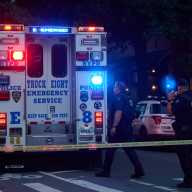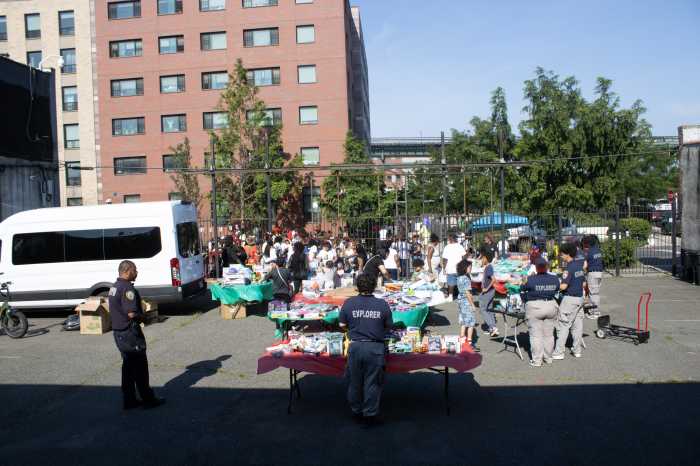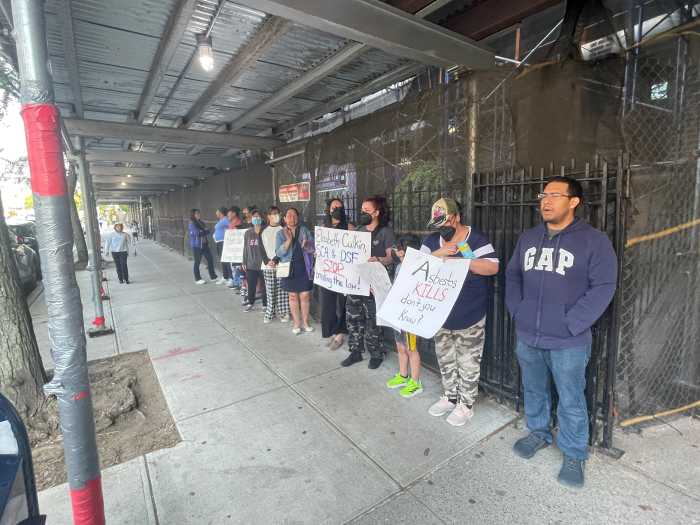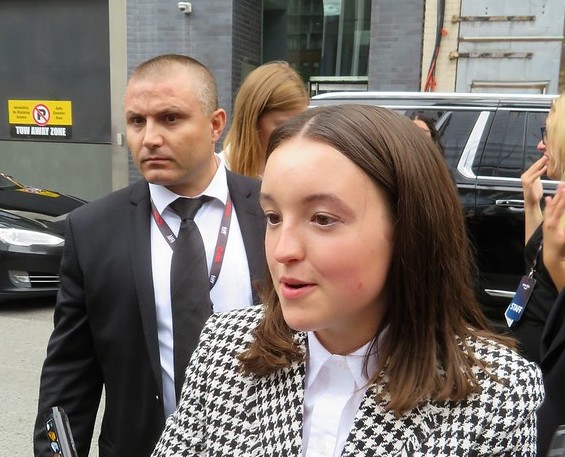
Rector St. is one of the Lower Manhattan subway stations slated for protection. Damage at the station, below.
BY DUSICA SUE MALESEVIC | The Metropolitan Transportation Authority has received $301 million in federal money to fortify Lower Manhattan subways.
More than 500 street openings — stairwells, elevators, escalators, sidewalk vents, access hatches and manholes — will either be capped by fixed or deployable covers, according to an announcement last month by Governor Cuomo’s office. These necessary street openings are where water can flood in, which is what occurred during Superstorm Sandy, Oct. 29, 2012.
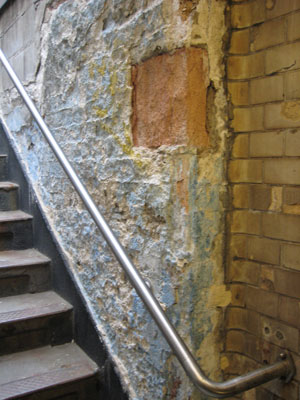 Lower Manhattan was deluged with water when Sandy hit and its stations were among the last to reopen.
Lower Manhattan was deluged with water when Sandy hit and its stations were among the last to reopen.
The M.T.A. is considering several different prototypes of manhole covers and deployable covers for elevators and stairways, M.T.A. spokesperson Kevin Ortiz wrote in an email. Possible options include a deployable sidewalk vent cover and two different manhole covers, one that has depth like a round baking pan and another like a solid tire with a handle jutting out, pictured in an M.T.A. report to Community Board 1 from late last year.
Other protective measures, said Ortiz, include $112 million for substations, which houses the machinery that powers the subways, $20 million for internal stations, $64 million for equipment and $24 million for pumping capacity.
The money will go primarily to five vulnerable stations close to the water: two on Rector, for the N, R and 1; Broad St. (J); Bowling Green (4,5); and Whitehall (N, R). Ortiz said that these five remain critical and will all receive the same protections.
“The M.T.A. bounced back quickly after Sandy,” Daniel Ackerman, chief of staff for the Downtown Alliance, sad in a phone interview. “[It is] taking the necessary steps to make the subway more resilient. I don’t think they can ever stop water from going into the tunnels and stations but to slow it, to decrease it and to sort of lower that vulnerability will help them bounce back even quicker next time.”
South Ferry
The new South Ferry station was also hit hard by Sandy two years ago. The M.T.A. spent $545 million to expand and renovate the station in 2009 and now the old South Ferry station, which has a short platform, is in use. The initial estimate to reopen the station was about $600 million, although Ortiz said it will be less but did not specify by how much. The M.T.A. is currently doing work to protect the old and new stations, but Ortiz would not say how much has already been committed.
South Ferry was completely flooded and almost everything inside was destroyed, said Zachary Campbell, assistant director for the M.T.A., at C.B.1’s Financial District Committee meeting on Oct. 1. The platform was strewn with debris, an escalator totaled, rust on the tracks and electrical equipment destroyed, he said.
The recently allocated $301 million is strictly for the fixed and deployable emergency flood covers for the five other stations, said Ortiz, when asked if any of the funding will go to South Ferry. The M.T.A. has three contracts to get South Ferry up and running again. The first is for near-term flood mitigation, said Campbell. Entrance one, which is in use, has bee-like yellow brackets with black stripes that can be used with deployable storm logs. Both entrance two and three are closed and two is currently capped. Storm doors in the interior of the entrances and glass on the doors and elevators will be thick and reinforced to be able to prevent it from breaking under water pressure.
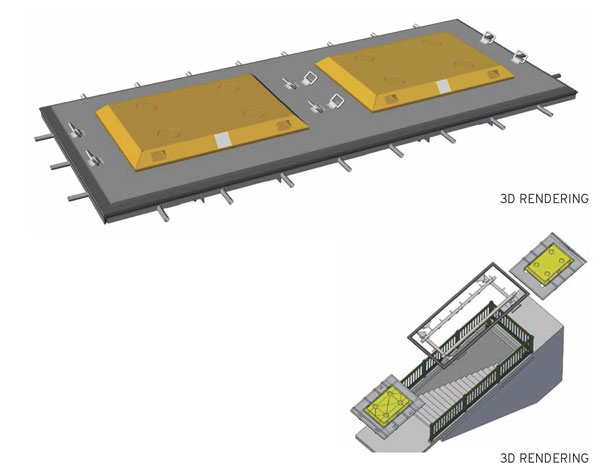
Campbell said that the flood mitigation measures at the entrances are designed to withstand a category two hurricane plus three feet, which is approximately 13 feet.
Currently, the interior of the station is being gutted and parts that were ruined due to water — wall panels along the tracks, tiling, ducts and ceilings — are being pulled out. Work began in June and should be completed by this November.
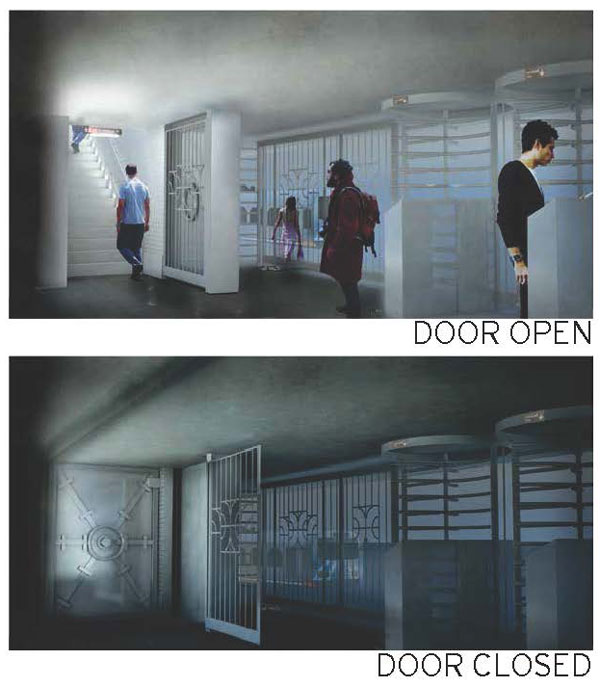
Another contact will be awarded at the end of October to reconstruct the station and “bring the interior back to the level” it was before, said Campbell. A new station, he said, which “can improve the connectivity that the old loop station that is currently in service there can’t provide. It’s a very important, critical station for us to bring back.”
Work on South Ferry can only be done in non-hurricane season, which means from December to May, he said. The new estimate for completion is now the end of 2016 or the beginning of 2017.
Other Funding
The funding was part of $1.915 billion allocated by the Federal Transit Administration to New York State: $1.6 billion will go towards M.T.A. projects, $212 million to the Port Authority of New York and New Jersey, and the New York Department of Transportation is expected to receive $200 million, according to a press release issued by Cuomo’s office last month.
Catherine McVay Hughes. Community Board 1’s chairperson, wrote in an email that “the funding for these important hardening of key transportation initiatives are critical for Lower Manhattan and we would like to thank Governor Cuomo very much for supporting these state agencies to prevent costly damage moving forward.”
Fifty-seven percent of the total area of C.B.1 district is in zone one, which is most at risk for flooding, according to a C.B.1 September 2013 report.
Montague Tube
The M.T.A. closed the Montague Tube, the R train between Whitehall St. in Lower Manhattan and Court St. in Brooklyn, in August 2013 to repair damages from Sandy — about 27 million gallons of water rushed into the 4,000-foot tunnel.
For it to be functional again, the M.T.A. had to replace 11,000 feet of track, 75,000 feet of power cable and 200,000 feet of communication cable, said Campbell.
To increase the tunnel’s storm resiliency, a critical relay signal room was repositioned higher, submarine-quality doors were installed in certain portions of the tube to protect facilities from water, and pumping capacity was increased, said Campbell.

Current entrance to the old South Ferry station. The newer station, which opened three years before Hurricane Sandy, will be closed for another two years, at least.
It cost approximately $250 million for the project and R train service resumed on Sept. 15.
“[With] the R train reopening slightly ahead of schedule, slightly under budget, the M.T.A. really seems to be making progress, working to learn from the issues that they encountered under Sandy,” said the Alliance’s Ackerman, who is also Lower Manhattan’s co-chairperson of NY Rising Community Reconstruction Program.































